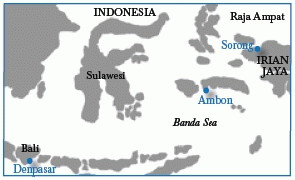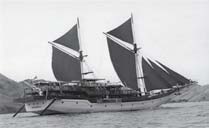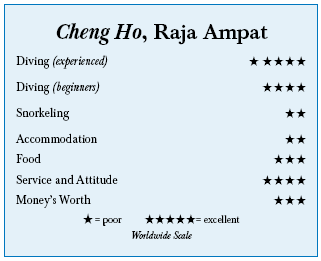Cheng Ho, Raja Ampat, IndonesiaContents of this Issue: All West Apartments and Diving, Curacao Thumbs Down: Sunset Divers, Curacao Wait Times for Flying After Diving Cheng Ho, Raja Ampat, Indonesia Tipping on Dive Trips: Part II What Happens If You Miss the Boat? Want to Sue That Dive Shop? Good Luck A Brief History of the Wetsuit Divers Saved After 40 Hours at Sea Sleek BCDs from Mares and Halcyon Editorial Office: Ben Davison Publisher and Editor Undercurrent 3020 Bridgeway, Suite 102 Sausalito, CA 94965 the diving is great, but the boat needs work from the June, 2008 issue of Undercurrent
Dear Reader: Raja Ampat, the “Four Kings” archipelago in Indonesia, is considered the epicenter of marine diversity -- 537 types of corals and nearly 900 fish species have been identified here. Many divers believe Raja Ampat has the best diving in the world. So the question is what boat to pick for diving? There used to be only two dive boats operating in Raja Ampat, now there are almost two dozen, most operating on a roundtrip itinerary from Sorong. I chose the Cheng Ho, Kararu Dive Voyages’ newest and biggest vessel, because its 12-day Banda Sea itinerary went from Ambon to Sorong and included more remote dive sites. I booked with Kirsten Treais of dive travel agency Amazing Adventures Travel, who brought 18 other Americans along. Some of us had the same goal -- to see the ocean’s deadliest critter, the blue ring octopus. The 160-foot teak schooner, formerly a Bali-based party boat, offers wireless Internet, a 48-inch plasma TV and dozens of electronic surge strips for cameras, chargers, and computers. But the nine-year-old gal is not aging well, with multiple cracks and holes that need to be plugged. Following a typical afternoon squall, ceiling leaks mysteriously appeared everywhere, even the lower deck. Some divers had to evacuate their cabins one night when leaks dripped over their beds. Hergen Spalink, one of the four American divemasters, advised us to keep anything electronic covered. “At least those leaks are not from the hull,” he offered as a joke. Anything stored in in the middle of the large salon, considered a “dry” area, was always kept covered. First stop was Laha Bay, a harbor that also serves as Ambon City’s garbage dump,
for some muck diving. While I’ve explored plenty of underwater landfills, the amount of
floating surface garbage was disgusting. I tried not to swallow any water and focused
on the amazing variety of critters. Two five-inch Pfeffer’s Flamboyant cuttlefish were
doing their mating dance, while intertwined snowflake eels only had their yellow eyes
on each other. Poking around in the nook of a boulder, I found a nest of transparent
juvenile flounder. Aside from the leaks, I still wouldn’t recommend the Cheng Ho’s cabins for comfort. My salon-level cabin was spacious, but other than having three windows, it just didn’t work. The desk and chair were blasted by the A/C unit opposite. Bunks are only for the strong and agile -- the top bunk was two feet from the ceiling, with the ladder three feet off the floor. I took the bottom mattress, which was on the floor and still not easy to get off of without hitting my back or head on the top bunk. The view from my airline-sized bathroom window was the crew’s kitchen, so they could see me reach behind the shower curtain for toilet paper. A shutter-like door to crew quarters banged my cabin every time someone went forward or aft. Finally after many nights being awakened at 4 a.m., I complained and found I was not the first. As for routine sightings of roaches and beetles, it’s not uncommon in the tropics. At least my ceiling was covered with plastic and cloth, which prevented rain from seeping into my room, unlike those on the lower deck. Even though they shrugged off cabin discomfort, the 22-person crew was friendly and service-oriented when it came to diving. Every time I went up the gangplank from the tender after a dive, I was greeted by some hooting and hollering crew with a highfive and “nice dive.” Kerri, Hergen’s partner, and Kristine were excellent critter spotters. Videographer Steve Fish was happy to point out critters. Divers were assigned to either the one metal or two fiberglass tenders, which had two rubber-lined benches and sturdy but short, narrow exit ladders. We simultaneously backrolled on a 1-2-3 count for an immediate descent. My only gear responsibility was to wear my weight belt and mask to the boat. I could put on my tank in the tender and take it off in the water. No requirements for dive time or buddy system. The Cheng Ho’s dive deck on the bow was covered in rubber matting, and lined with aluminum 80 tank holders and sit-on bins for gear. With 20 divers gearing up at once, it got cramped but with three tenders, we tried to dress at varying times. Three tubs for cameras, masks and wet suits were changed daily, and there was a “wet” table for camera gear and hangers for dry suits. There were two deck showers, but only enough pressure to use one at a time, and the only toilets were in the cabins.
Nitrox was used by almost everyone for an additional -- and steep -- $200. Divers were tracked by whether their tank was in the water or holder, and anyone not going on a dive was to cross their name off the tender list. Adom, the tank filler, always brought me a sheet to sign off for percentages (although an analyzer was available), and he was consistently between 31.5+ and 32 percent. Briefings were accurate as to the terrain and potential critters, but the current was too squirrelly to predict. Air and water temperatures were in the 80s, so divers wore skins or 1- to 3-mil suits. After three days of clear-water diving at channel and wall sites down to 100 feet, we went to Misool’s Mylangkawi Blue Water Mangroves, saltwater channels meandering through four black mangrove-edged atolls. Down at 10 feet, mangrove roots supported large plumes of soft coral, with inhabitants like Palau-sized tridacna clams, shy tomato anemone clownfish, pygmy sea horses camouflaged in pink fans, gold-speckled jawfish and a tasseled wobbegong shark slumbering in the sand. The archer fish, which prey on insects by spitting at them, schooled on the surface. My days began around 6:30 a.m. with croissants or toast, tea, coffee, and fresh fruit and cereal, with a full breakfast after the morning dive at 8 a.m. Lunch was buffet- style in the salon but if the boat wasn’t under way, dinner was served outside on the upper deck. Each meal featured a different ethnic dish: Indonesian, Western, Japanese, Chinese, or Indian. While food was plentiful, the presentation and flavor were ordinary, and the repetitious rice and noodles got to me after a few days. Sodas were complimentary, beers were $2 but wine was only available by the bottle at $18. Night diving produced the most interesting critters. At Jef Vam, a village of 25 families, I dived the pier to see robust pipe fish, cowries, hermit crabs, and juvenile lionfish. A rare mimic octopus contorted its body, changed color and playacted as a sea snake. Another night near the pearl farm at Waigeo’s Aluji Bay, I came upon crocodile fish, a red spider crab and signal gobies coming out from the shadows. While I packed in three day dives and a night dive whenever possible, part of the fun was the non-diving activities. At Waigeo’s Aluji Bay, I visited the Atlas South Sea pearl farm, which cultivates 200,000 pearls annually, some as large as 20 millimeters. And one evening, fun-loving Kirsten insisted everyone wear a sarong to a cocktail beach party. With the rum pouring freely, along with beer and wine, several divers lost whatever inhibitions they had left and plunged into the water. Heading to Sorong, we spent a day near the island of Kri and its underwater seamount,
Sardine Reef. Hergen passed out reef hooks, twice the size of those used in
Palau, because it was easy to be swept over the seamount if your descent wasn’t fast enough. I latched my hook onto dead
coral to stay put in the current and
watched schools of curious batfish,
tuna, reef sharks and trevally parading
by. Next time, I would pick another Raja Ampat boat. The Cheng Ho has friendly crew with excellent diving service, but the literal cracks on the surface prevent them from offering an excellent experience overall. For the amount of money they charge, you should only be getting soaked in the sea or the shower, not in bed. -- M.S.
|

I want to get all the stories! Tell me how I can become an Undercurrent Online Member and get online access to all the articles of Undercurrent as well as thousands of first hand reports on dive operations world-wide
| Home | Online Members Area | My Account |
Login
|
Join
|
| Travel Index |
Dive Resort & Liveaboard Reviews
|
Featured Reports
|
Recent
Issues
|
Back Issues
|
|
Dive Gear
Index
|
Health/Safety Index
|
Environment & Misc.
Index
|
Seasonal Planner
|
Blogs
|
Free Articles
|
Book Picks
|
News
|
|
Special Offers
|
RSS
|
FAQ
|
About Us
|
Contact Us
|
Links
|
3020 Bridgeway, Ste 102, Sausalito, Ca 94965
All rights reserved.

 Colorful mandarin fish swam in the open instead of waiting for their dusk mating ritual. The visual overload
included waspfish, leaf scorpionfish,
leafy-gilled sea moths cruising the sandy
bottom, and frog fish as large as soccer
balls. Divemaster Kerri Bingham spent an
hour looking for a recently discovered and
yet unnamed species of frog fish, pink with
green eyes. When she asked local divers if
they had seen it, they sheepishly removed
boulders where they had “hidden” the rare
species by blocking its movements. Critter
spotting was as good as in renowned Lembeh
Strait, with visibility averaging 60 feet
and water temperature a tepid 84 degrees.
Colorful mandarin fish swam in the open instead of waiting for their dusk mating ritual. The visual overload
included waspfish, leaf scorpionfish,
leafy-gilled sea moths cruising the sandy
bottom, and frog fish as large as soccer
balls. Divemaster Kerri Bingham spent an
hour looking for a recently discovered and
yet unnamed species of frog fish, pink with
green eyes. When she asked local divers if
they had seen it, they sheepishly removed
boulders where they had “hidden” the rare
species by blocking its movements. Critter
spotting was as good as in renowned Lembeh
Strait, with visibility averaging 60 feet
and water temperature a tepid 84 degrees.
 As the afternoon current picked
up, the scene turned into a foodchain
feeding frenzy as sharks moved
in to eat barracudas, who ate jacks,
who ate the fusiliers, and on down
the line. At Kri jetty, I achieved my
goal of seeing not just one but two
deadly blue-ringed octopus. The thumbsize
critters flashed their blue spots
at my flashlight so I finned back to
avoid any deadly squirts of venom.
What a thrill! It made dealing with
some of the boat’s dysfunction actually
worthwhile.
As the afternoon current picked
up, the scene turned into a foodchain
feeding frenzy as sharks moved
in to eat barracudas, who ate jacks,
who ate the fusiliers, and on down
the line. At Kri jetty, I achieved my
goal of seeing not just one but two
deadly blue-ringed octopus. The thumbsize
critters flashed their blue spots
at my flashlight so I finned back to
avoid any deadly squirts of venom.
What a thrill! It made dealing with
some of the boat’s dysfunction actually
worthwhile. Diver’s Compass: Cheng Ho’s per-person rates are $325 to $375 per
night, single occupancy is an extra $225; groups of 8 to 17 divers
pay $325 per night . . . Same-day laundry service was 50 cents
to $1.50 per item, and a massage therapist charges $15 per hour . .
. I took a comfortable flight on the Taiwanese airline EVA from LAX
to Denpasar, Bali via Taipei, for a coach fare of $1,500 . . . Kararu
Dive Voyages arranges flights between Bali and Ambon or Sorong;
for Sorong departures, an overnight stay is required in Makassar,
Sulawesi, which Karuru arranged for me . . . I took Malarone for
malaria with no side effects . . . Web sites -- Cheng Ho:
Diver’s Compass: Cheng Ho’s per-person rates are $325 to $375 per
night, single occupancy is an extra $225; groups of 8 to 17 divers
pay $325 per night . . . Same-day laundry service was 50 cents
to $1.50 per item, and a massage therapist charges $15 per hour . .
. I took a comfortable flight on the Taiwanese airline EVA from LAX
to Denpasar, Bali via Taipei, for a coach fare of $1,500 . . . Kararu
Dive Voyages arranges flights between Bali and Ambon or Sorong;
for Sorong departures, an overnight stay is required in Makassar,
Sulawesi, which Karuru arranged for me . . . I took Malarone for
malaria with no side effects . . . Web sites -- Cheng Ho: 